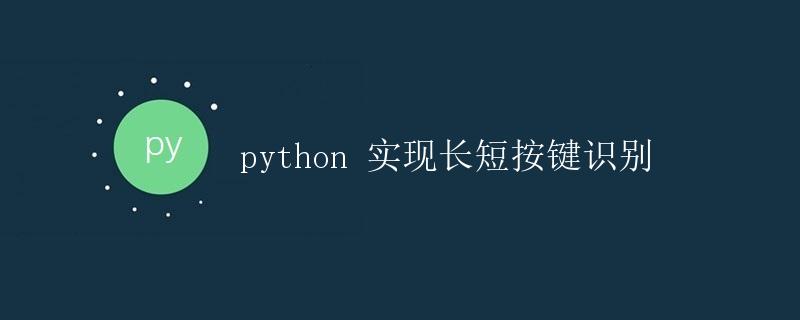Python implements long and short key recognition
Implementing Long and Short Keystroke Recognition in Python

In many applications, we often need to identify user keystrokes, with long press and short press being two common types. Distinguishing between long and short presses allows for more flexible response to user actions and improves the user experience. In this article, we will use Python to implement long and short keystroke recognition.
Overview
Before implementing long and short keystroke recognition, we first need to understand some basic concepts:
- Short press: A key is pressed and then released immediately, i.e., a keypress is pressed for a short time.
- Long press: This occurs when the user presses and holds a key for a specified period of time before releasing it.
In Python, we can identify long and short key presses by monitoring user key events. Generally, we can use the standard library pygame to monitor key events. Below, we’ll explain how to use the pygame library to implement long and short keystroke recognition.
Implementation Steps
Step 1: Install pygame
First, we need to install the pygame library. You can install it using the following command:
pip install pygame
Step 2: Implement long and short keystroke recognition
Next, we’ll use example code to demonstrate how to implement long and short keystroke recognition. In this example, we will monitor the length of time the user presses a button. When the button is pressed for longer than a certain threshold, we consider it a long press, otherwise it is a short press.
import pygame
from pygame.locals import *
# Initialize pygame
pygame.init()
# Set the screen size
screen = pygame.display.set_mode((400, 300))
# Set the start time for key presses
key_down_time = 0
# Set the long press threshold (in milliseconds)
LONG_PRESS_THRESHOLD = 1000
# Game loop
while True:
for event in pygame.event.get():
if event.type == QUIT:
pygame.quit()
exit()
if event.type == KEYDOWN:
if event.key == K_SPACE:
key_down_time = pygame.time.get_ticks()
if event.type == KEYUP:
if event.key == K_SPACE:
key_up_time = pygame.time.get_ticks()
key_press_time = key_up_time - key_down_time
if key_press_time >= LONG_PRESS_THRESHOLD:
print("Long press")
else:
print("Short press")
In this sample code, we first import and initialize the pygame library and then set the screen size. Next, we define a variable key_down_time to record the duration of a key press. In the main game loop, we listen for key events, recording the duration of the key press when it’s pressed and calculating the duration of the key press when it’s released. Finally, by comparing the key press duration with the threshold, we determine whether the user pressed the key for a long or short time.
Running Results
When we run the sample code above, we can see the corresponding results of each key press in the command line. If the key is pressed for more than one second, “long press” is output; otherwise, “short press” is output.
This method allows us to easily identify long and short key presses, allowing for more flexible response to user actions within our applications.
Summary
In this article, we demonstrated how to use Python to identify long and short key presses through sample code. By monitoring user key press events and combining the duration of the key press, we can easily distinguish between long and short presses.